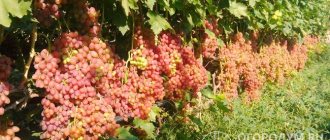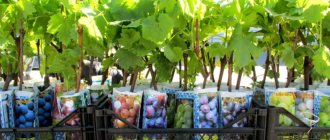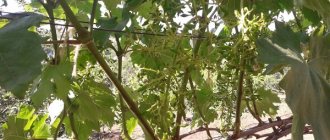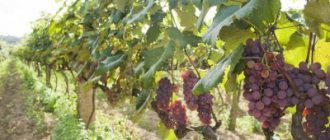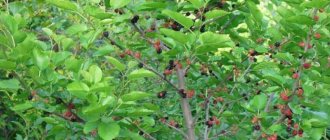Features of growing grapes in the Moscow region
To achieve ripening of grapes, you must follow several rules on how to grow the plant. It is recommended to plant the berries on the south side of the site, near buildings or any structures along which the vine will curl. Varieties with berries with a dark tint have higher requirements for the growing zone .
Planting crops in the Moscow region is carried out according to several rules:
- depending on the type of soil, a hole is dug 25-50 centimeters;
- before planting, the bottom of the pit is trampled down, after which it is filled with preheated water;
- A mixture of organic matter, ash, potassium, nitrate and superphosphate is used as fertilizer.
For the Moscow region, varieties are chosen that have time to ripen before the ambient temperature drops to sub-zero levels. The crop is planted in open and heated ground.
By observing all the characteristics of cultivation, you can achieve constant and high yields. It is also important to cover the grapes before the onset of cold weather.
Tips for choosing a variety
The list of the best grape varieties includes early, frost-resistant and non-covering plants. Suitable for growing in the Moscow region:
- Aleshenkin. These grapes, after planting in the Moscow region, produce a harvest in 118 days. The brushes are very large (reach 1.5 kilograms). This variety is distinguished by the fact that the berries do not contain seeds. Aleshenkin remains viable at a temperature of -26 degrees. However, this variety has poor resistance to fungi.
- Victoria. The grapes of this variety are harvested after 4 months. The berries are distinguished by their dark pink hue, large size and sweet taste. The weight of the brush reaches 1 kilogram.
- Lydia. The berries are dark in color and have a sweet and sour taste. Lydia tolerates waterlogging of the soil and the effects of mildew and oidium well. The harvest appears 5 months after flowering. Lydia forms small brushes weighing about 100 grams.
- Kuderka. Despite the fact that the grapes bear fruit late, the vine has time to ripen in the Moscow region. This is explained by the fact that the variety can withstand frosts down to -30 degrees and makes few demands on the growing area. Couderka is considered a technical variety of grape, as it is used mainly for making wine.
- Jupiter. The harvest can be harvested after 4 months. The weight of Jupiter's clusters reaches 500 grams. The berries are purple in color and have a sweet and slightly nutmeg flavor. Jupiter can withstand frosts down to -27 degrees.
- Sovering Tiara. The plant produces a harvest by mid-August. The weight of the bunch is small and is about 200 grams. The three-year-old vine can withstand frosts down to -30 degrees. The taste of the berries is sweet and sour.
- Valiant. The grapes are distinguished by powerful vines, the length of which reaches 10 meters. The harvest can be harvested closer to the beginning of autumn. An adult vine can withstand frosts down to -10 degrees.
- Phenomenon. The white-yellow berries are mainly suitable for making wine. The weight of the bunch reaches 1 kilogram. This variety produces a harvest by early autumn.
- Alpha. The variety is well suited for planting in the Moscow region, as it can withstand frosts down to -35 degrees. Alpha produces a harvest by the end of August. You can harvest up to 10 kilograms from one vine.
- Buffalo. In the Moscow region, such grapes produce a harvest in mid-September. The plant manages to ripen before the onset of autumn cold weather.
For the Moscow region, it is recommended to select self-pollinating crops. The optimal choice would be a crop that can withstand the effects of pathogenic fungi.
Collection, packaging and secrets of storing grapes
The ripening of grapes consists of increasing sugar content, decreasing acidity, improving color, pulp structure, and taste inherent in a particular variety. Harvesting of table grape varieties begins with the onset of full consumer maturity, close to physiological.
Their readiness for harvesting is determined by external taste characteristics and the sugar content and acidity of the berry juice. The berries of white grape varieties, when ripe, become elastic, transparent, light, and the skin becomes covered with a waxy coating. The berries of colored varieties acquire their characteristic color: light pink, dark pink, black, purple, blue, etc. By the time of harvest, table grape varieties accumulate sugar from 15 to 20% or more with an acidity of berry juice of 4–7 g /l. Slightly different requirements apply to technical varieties: ● to prepare grape juice, technical grape varieties with a sugar content of 14–16% and an acidity of 5–7 g/l are used; ● for dry table wines, technical grape varieties with a sugar content of 18–19% and acidity of 7–8 g/l are used; ●for dessert wines, technical grape varieties with a sugar content of 20–24% and acidity of 5–6 g/l are used; ●for champagne wine materials, technical grape varieties with a sugar content of 17–18% and acidity of 9–11 g/l are used.
For known reasons, the process of ripening bunches on grape bushes does not occur simultaneously. Clusters ripen earlier on normally developed shoots located closer to the soil and at the base of the shoot. Therefore, it is necessary to carry out selective harvesting (one, two, and even three times) as the required sugar content and acidity of the berries occur.
It is best to harvest all grape varieties in dry, sunny weather. Grapes with traces of dew or rain on the berries should not be picked. If it starts to rain during harvesting, harvesting is immediately stopped for two to three days until the moisture inside the bunches has completely evaporated.
It is necessary to cut bunches of grapes with pruners and scissors with blunt ends. During cutting, the bunch is held by its stem so as not to erase part of the waxy coating from the berries, which protects them from drying out and rotting. Clusters that have a short stalk are supported from below with the palm of your hand when cutting. Before placing them in boxes or baskets, diseased and shriveled berries are removed from the bunches with scissors. The capacity of boxes and baskets should not exceed 8 kg. The inner walls of the container must be well lined with grape leaves or paper.
Landing dates
In order for the crop to take root in the Moscow region, it is necessary to adhere to the deadlines for planting the vine. Moreover, the choice of period is influenced by the type of variety. Planting of crops in the Moscow region is carried out in spring or autumn. If the first option is chosen, you must wait until the soil warms up to a temperature of +10 degrees.
It is important not to miss this moment. Late seedlings do not take root well.
It is recommended to leave annual plants for autumn. Such grapes should be carefully removed from the storage container. In young shoots, the roots are damaged due to minor loads. Planting must be completed by mid-October.
See also
Description and characteristics of Iran's Shahin grape variety, planting and careRead
Downy mildew
Mildew (downy mildew).
It is dangerous because it develops throughout the growing season, and affects almost all green parts of the plant. Infection occurs very quickly in damp and rainy weather, when the ambient temperature is not higher than 13 degrees Celsius. A sign of the onset of the disease is the appearance of oily spots of various shapes on the leaf blades. Gradually they become covered with clearly visible mycelium, resembling white threads. The “Lydia” grape is especially sensitive to this pathogen: in the Moscow region, planting and caring for this variety is relatively simple, but you should never forget about this circumstance! As soon as such a plaque appears, we can assume that the entire bush is affected. At the site of the lesion, the leaf tissues quickly crumble, drying out, and with severe damage, the entire leaf blade simply falls off. The same fate befalls young shoots, berries and buds. Older shoots are very stunted in growth. Practice shows that at the first outbreak of downy mildew, up to 80% of the entire crop is lost, and many bushes die. In damp and humid weather, the development of the disease occurs almost instantly, killing almost all the grapes. Growing and caring for it in the Moscow region is complicated by the unstable climate!
Selection of seedlings and site
The choice of planting site in the Moscow region must be done with special diligence. Despite the fact that the plant loves an abundance of light rays, growing the vine in open areas is not recommended. Such planting in the Moscow region will lead to rapid freezing of seedlings.
Suitable areas for grapes are those that meet the following requirements:
- south or southwest side;
- during the day it is illuminated by the sun for a long time;
- there is wind protection;
- there are no natural slopes;
- In spring the earth warms up quickly.
Grapes can grow in different types of soil. Black soil or sandstone are considered optimal for planting. Can also be grown in loam. Moreover, the latter option is the most suitable, since this type of soil is looser, which means it warms up faster in the spring. Planting the crop in wetlands is not recommended. Most varieties do not tolerate excess moisture, which causes fungal diseases to develop.
It is recommended to purchase seedlings in the spring, before the first days of April. For planting in the Moscow region, sprouts with lush, light-colored roots are suitable. When working with seedlings, it is necessary to prepare planting material. To do this, the roots are trimmed so that the resulting length is about 18 centimeters. Before planting, the lower part of the seedling is dipped in a solution of clay (2 parts) and fermented mullein (1 part), and the upper part is dipped in molten wax or paraffin.
Boarding procedure
To plant crops in the Moscow region, it is recommended to choose zones with multi-layer soil and acidity in the range of 6.5-7. Grapes should not be grown in soil with a high limestone content.
The soil is prepared by mixing in equal proportions:
- loam;
- crushed brick (gravel);
- sand;
- humus.
Ash and superphosphates are also added to the composition at the rate of 500 grams and 50 grams, respectively, per 1 square meter. Such soil freely allows water and air to pass through, providing normal nutrition to the vine. The optimal time for planting a crop with a closed root system is May-June, with an open one - April-May or October.
If you plan to grow several plants on the site, holes should be dug at a distance of more than 1.5 meters.
Regardless of the chosen variety, the crop in the Moscow region is planted to a depth of up to 25 centimeters. Before burying the plant, you must:
- straighten the roots, thereby preventing kinking;
- place the top bud at a depth of 5-8 centimeters;
- tilt the vine towards the north.
After planting, the seedling must be tied to a support along which it will curl. At the end, the grapes are watered generously with warm water and covered for a while with a dark film.
How to plant correctly in the open ground at the dacha
Before you start planting grapes at a dacha near Moscow in open ground, you need to familiarize yourself with a number of conditions without which it is impossible to achieve success.
Landing dates
There are two options for planting grapes in the Moscow region - early spring or the first half of autumn before frost sets in. Spring is preferable. At this time, cuttings can be planted in open ground. Planting begins at a soil temperature of 10 °C. Only annual plants are suitable for autumn planting; cuttings will not take root at this time.
Choosing a location and preparing a pit
The optimal place for growing grapes is the south side, protected from wind and drafts by a fence or low buildings. But you shouldn’t plant it close to the building. The distance should not be less than a meter. Grapes prefer loamy and sandy soil.
Important! If the soil is dense and clayey, then the prepared hole should have a good layer of drainage.
The planting hole should be 1.5 x 1.5 m wide and 50 cm deep. 5 buckets of compost, 4 buckets of sand, and a little wood ash are added to the dug hole. All this is thoroughly mixed. The pit is ready. For spring planting, the hole is prepared in the fall.
Preparing a planting hole for grapes
The seedlings are cleaned of wilted, rotting, non-viable roots and soaked in water for 2 days, after which the future grape bush is ready for planting.
How to plant: diagram
To properly plant a grape seedling in the Moscow region, you should adhere to a certain scheme:
- Prepare a 40x30 cm hole in the center of the pit.
- Pour 2 buckets of water into the hole and make a small mound in the center.
- The seedling is placed on a prepared mound and the roots are straightened.
- The upper bud of the shoot is located 8 cm below ground level.
- Fill the hole with the remaining soil, compact it, water it and cover it with a piece of plastic bottle with holes for ventilation. It should be opened only when the seedling has taken root.
Grape care
Regardless of the type of variety grown in the Moscow region, grapes require care. By following certain recommendations, you can get a large harvest every year. There are several rules on how to care for grapes growing in the Moscow region. Starting in early spring, it is necessary to apply mineral fertilizers. The soil around the vine is mulched using rotted leaves, which are laid to a depth of more than three centimeters.
When growing a plant in the Moscow region, it is important to prevent magnesium deficiency in the soil. A deficiency of this microelement leads to the death of the vine. To prevent the development of diseases, the plant should be sprayed every two weeks. For this, a special product is used, which is prepared by mixing 250 grams of a mixture of magnesium and sulfur and a bucket of water.
In the spring, mineral fertilizers with a liquid composition are also applied every week (before the berries ripen). The following is used as fertilizing:
- for soil with a high alkali content - compositions that acidify the soil;
- for acidic soil - alkalizing compounds.
See also
Description and characteristics of the Ruby Jubilee grape variety, cultivation and careRead
During the period when the growing season has begun, humus from the leaves should be added, while simultaneously treating the trunk with fugicides. It is important to water the grapes in a timely manner, avoiding waterlogging of the area. When growing a plant in the Moscow region, you should ensure that water penetrates to a depth of 50 centimeters. Usually 10 liters applied every week is sufficient for the vine. Watering is carried out in grooves that break through near the trunk. At the end of August, they stop supplying water, as during this period the berries gain flavor.
When caring for vines, agricultural techniques are not usually used. The need for mechanized installations arises when several plants are simultaneously grown on a site.
How to protect grapes from diseases and pests
Caring for a vineyard is not limited to watering and fertilizing. Fungal diseases of grapes create many problems for gardeners in the Moscow region. Shoots and fruits suffer from mildew. Symptoms of infection appear on leaves in late summer:
- yellow spots on the outside;
- there is a gray coating on the inner surface.
In the Moscow region, oidium infects vines throughout the growing season. The fungus multiplies intensively during drought and irregular watering. Z
Oidium
Affected berries rot and crack. Measures to combat mildew and powdery mildew are similar:
- removal, burning of leaves in autumn;
- spraying with fungicides;
- dusting bushes with powdered sulfur;
- high tying of the vine.
To prevent fungus, the first spraying with fungicides is carried out when the shoots grow to 20-30 cm, repeated - after flowering, subsequent ones - 2-3 times a week. During fruit ripening, the bushes are not treated. Grape pests in the Moscow region:
- spider mite;
- grape mealybug;
- cluster leaf roller;
- Khrushchi;
- wasps.
| A drug | Disease, pest of grapes | Vine development phase |
| inkstone | mildew, oidium, hay rot | early spring, dormant state, after harvest |
| Tiovit Jet | during the opening of the kidneys | |
| Topaz | in 3 leaf phase | |
| Ridomil Gold | during flowering, in the pea phase | |
| Aktellik | spider mite | kidney opening |
| Decis | mite | phase 3 sheets |
| Confidor | 1st generation leaf roller | bloom |
| Match | 2nd generation leaf roller | pea phase |
| Taurus | 3rd generation leaf roller | softening the berries |
Shaping and trimming
Forming the crown allows you to avoid the appearance of shoots that will not produce a harvest. But to do this you need to know how to trim grapes. When growing a plant in the Moscow region, the crown begins to form in the fall, from the second year. During the first season, experienced gardeners recommend not touching the seedlings. Within a year after planting, the vine should get stronger and gain the necessary strength.
Starting from the second season, they begin to form shoots. Pruning is carried out in two stages:
- In autumn. Before cold weather, cut down to 2/3 of the vine that requires removal.
- In the spring. Frozen or defective shoots are removed.
It is recommended to monitor the development of shoots from the beginning of the appearance of shoots. Large branches should not be allowed to appear. In this case, the grape yield will decrease.
The simplest method of circumcision is considered to be the Guynot method, which involves performing the following manipulations:
- In the first year after planting, they are pruned in the fall, leaving two “eyes” above the soil surface.
- In the second year, 2 regrown annual shoots are cut off. The first is left long to form clusters, the second is shortened to three “eyes”.
In the third year, a strong vine will appear from the second “eye”, which will produce a harvest.
How to cover grapes for the winter?
Preparation for the cold season begins in autumn. Grapes growing in the Moscow region should be covered for the winter during the period when persistent night frosts with a temperature of -2 degrees appear. In the process of preparing the plant for cold weather, soil or peat is used. To provide shelter for the winter, the cut shoots are covered with 10-15 centimeters of soil.
If necessary, the vine, using improvised means or branches, is fixed to the surface of the earth. The top of the plant is covered with spruce branches. If the vine grows along the wall, boards are laid on top of the cut shoots, which will protect the grapes from water flowing from the roof.
In order for the vine to retain its ability to produce crops, it is recommended to collect as much snow as possible and place it in the place where the crop grows. To insulate the plant, you should not use plastic film. In the absence of spruce branches, straw or leaves are used.
Harvest procedure
Most varieties produce harvest either in late August or early September. Some types of grapes ripen in the Moscow region for one month. It is important to harvest the crops on time. Overripe berries have an unpleasant taste and are suitable for making homemade wine. In addition, late harvest attracts pests.
The berries are picked by hand. The bunches are trimmed using garden pruners. When harvesting, care should be taken not to damage the berries. Fruits with defects quickly rot, causing the entire bunch to suffer.
How and when to harvest correctly?
Remember that even if the berries are fully colored, they are not yet fully ripe. Fruits need to accumulate a certain amount of sugars, as a result of which they acquire the delicate taste and aroma familiar to everyone. For early varieties this period is about five weeks, but late varieties can ripen up to two months. Please note that when picking grapes with your bare hands, you destroy the protective wax film, which leads to rapid spoilage of the product. Therefore, be sure to work with gloves, try to hold the bunches by the “stalk”, and cut them with pruning shears.
Berries collected in this way can be stored for a very long time, ripening along the way. The latter is extremely important in the conditions of the Moscow region and the entire Central Zone, since grapes do not ripen everywhere. Planting and care (in the Moscow region) is very important to do correctly, but if you can make a mistake during cultivation, then bad pruning will put an end to the vine!
